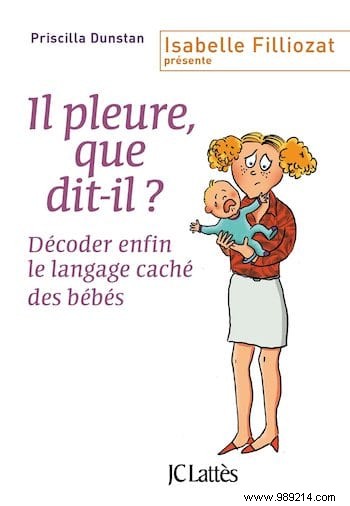
With a newborn, parents often stress.
Why ? Because they want what's best for their baby!
They are constantly trying to guess what baby wants and needs.
But without the words to communicate, it's not easy to understand baby...
Fortunately, pediatricians have developed simple and effective techniques to better communicate with baby.
Here are 22 tips to finally understand baby's crying and gestures:

Crying is baby's only way of expressing himself during the first 4 months of his life. But how to understand what baby really wants? How do you know if he is crying because he is hungry, sleepy or because he is in pain somewhere?
It's a real headache for parents! With these little tricks that pediatricians know well, it's easier to understand baby's crying:
- Crying to call. Baby has been alone for some time and now he would like his parents to pick him up. He cries nonstop for 5 to 6 seconds, then he pauses for about 20 seconds. As if he was waiting to see if it worked... If the parents don't come, this cycle repeats several times before the baby starts crying continuously.
- Crying because of hunger. Everything can start with a cry of call. But if his parents have not come to pick him up and feed him, then the baby starts crying continuously and then hysterically. Baby can also turn his head and make sounds with his mouth.
- Crying because of the pain. The crying is monotonous, loud and constant. There may be more strident bursts indicating that the pain is increasing. But if baby is sick, his crying can be quite monotonous. He can even cry softly, because he doesn't have enough strength to cry louder.
- Crying due to a physiological problem. Gas, peeing or pooping can be a source of discomfort for a baby. In this case, crying sounds like moaning.
- Crying because of fatigue. When baby is sleepy but can't fall asleep for some reason, his cries sound like little plaintive moans followed by yawns. Baby also tends to rub his eyes and ears.
- Crying due to discomfort. These cries are nervous and intermittent. Baby often fidgets at the same time. It can also struggle and arch. This means that it is high time to check if the diaper is not dirty, or if he is not too hot or cold with his clothes.
- Finally, toddlers can also cry when the environment changes, when they are frustrated or bored.

For more than 20 years, Australian pediatrician Priscilla Dunstan has studied and researched the sounds newborn babies make. His research involved thousands of babies of different nationalities. Priscilla Dunstan believe that the primary sounds emitted by newborns are the same regardless of their nationality.
After 4 months, baby makes sounds in order to communicate more about his physical needs. Priscilla Dunstan opened her own school to teach parents how to better understand their babies. Because she thinks deciphering these sounds in time will prevent baby from crying.
Here is the dictionary of newborn sounds:
- Nèh:"I'm hungry". When baby is hungry, he wants to breastfeed. He will therefore simulate sucking by sticking his tongue against the palate and then lowering it, while crying. If you have any doubt, take a good look at his tongue. Is it placed at the top of his mouth? In this case, the best thing is to try to feed him. To hear the exact sound, turn on the sound in the video below at the bottom right:
- Eh:"I have to burp". After feeding, air may remain blocked in the esophagus or digestive tract. His muscles contract to try to expel him, hence the noise. This is the belching reflex. Often, baby squirms at the same time, because he feels bad. Take him in your arms and straighten him up to make him burp. Don't put him down until it's done. To hear the exact sound, turn on the sound in the video below at the bottom right:
- Aoh:"I'm tired". When baby is sleepy, he yawns like you! His mouth then forms an O and the tongue will stick down, which has the effect of lowering the larynx. When baby cries while doing these movements, it causes the sound "aoh". To hear the exact sound, turn on the sound in the video below at the bottom right:
- Èerh:"I have gas". This moan is the consequence of the spontaneous contraction of the abdominal muscles, caused by the presence of gas in the large intestine. Often baby has his mouth half open when he makes this sound and his tongue is placed at the back of the mouth. In addition, he tends to clench his fists and stiffen his legs. In this case, the best is to gently massage his belly. You can also lay baby on his stomach on your forearm, to put light pressure on his stomach. To hear the exact sound, turn on the sound in the video below at the bottom right:
- Heh:"I don't feel well". Too hot, too cold, wet diaper... There are many reasons why babies feel bad. Baby will then let out a kind of big sigh in a sob. It will then be necessary to find the cause of his discomfort. To hear the exact sound, turn on the sound in the video below at the bottom right:
- Gen:"I have a toothache". From 12 weeks, baby will start teething, which is always painful. This pain triggers a reflex of salivation and chewing. Baby will swallow, while moving the jaws. You will easily recognize this phase, because baby is salivating a lot more than usual and he puts his fingers in his mouth, as if he wanted to massage his gums. You can apply a soothing cream or give him a teething ring to chew on for relief. To hear the exact sound, turn on the sound in the video below at the bottom right:
- Nah:"I'm thirsty". Baby has a dry mouth. He tries to swallow to get her wet. This sound is the consequence of a sucking reflex. His tongue slides back and forth. Since he cries at the same time, it produces this sound. In this case, give him a drink quickly. To hear the exact sound, turn on the sound in the video below at the bottom right:
- Yes:"I can't take it anymore". Baby is stressed and twitches. Its mouth is closed and the sound that comes out is loud and sometimes high-pitched and repetitive. His whole body is rigid. He can make jerky movements and his chin quivers. Reassure him quickly by taking him in your arms. To hear the exact sound, turn on the sound in the video below at the bottom right:
- Lelaol:"I feel alone". For babies, interactions with others are essential to their development and well-being. When he feels alone, baby is stressed, which generates hormones. Small compulsive movements of the diaphragm produce this sad, plaintive sound. Paradoxically, baby can be calm. Here again, it is important to reassure baby, to take him in his arms and to cuddle him. To hear the exact sound, turn on the sound in the video below at the bottom right:

Body language says a lot about baby's well-being.
- He arches his back. Babies under two months of age often do this movement in response to pain and colic. If baby arches his back after eating, it means he is full. If baby makes this movement often, it may mean that he is bothered by reflux. A baby who is over 2 months old and who does this movement shows his bad mood and fatigue.
- He turns his head left to right and right to left. Baby makes this gesture to soothe himself before falling asleep. He can also do this when surrounded by strangers.
- He catches his ears. In most cases, baby is simply exploring his body when he makes this gesture. But if he does it often and cries at the same time, you should consult a doctor, because he may have ear pain.
- He clenches his fists. It shows that baby is hungry. If you notice this gesture, you can easily avoid her crying which is caused by hunger.
- He raises his legs. This is the sign of colic and stomach aches. It is a reflex to relieve pain.
- He shakes his arms. This movement shows that baby was afraid. Loud noise, bright light, sudden awakening can cause this reflex. In that case, comfort baby.

Pediatricians recommend talking with your baby as often as possible.
Indeed, it is important to explain and show him everything that is happening in his environment.
Even if it looks like he doesn't understand much!
Indeed, it helps him to communicate quickly with his loved ones using sounds and gestures that are unique to him.
Talking with your baby regularly contributes to his good development.
If you want to know more to understand and decipher baby crying, I recommend Priscilla Dunstan's book:He's crying, what does he say?

Have you tried these tricks to decode baby talk? Let us know in the comments if it worked for you. We can't wait to read you!